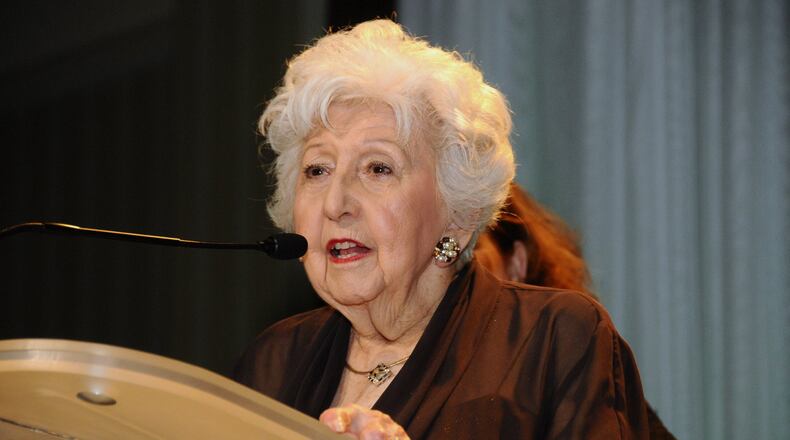Shirley Borenstein remains committed at age 100 to a cause that’s close to her heart: a cure for Type 1 diabetes.
About 1.6 million Americans, including two of her grandchildren, live with this disease and its potentially debilitating side effects.
One grandchild was diagnosed with Type 1, or juvenile diabetes, at three years old in 1981. A second grandchild was diagnosed a few years later at age 9.
As a medical technologist and cardiac researcher Shirley wasn’t just content to be the doting grandmother. She turned this personal heartache into action – devoting the past 35 years to helping the Juvenile Diabetes Research Foundation (JDRF) in its efforts to find a cure.
“That just seemed like the thing I needed to do,” said Shirley, who retired from Emory University in 1985 but never really stopped working.
Instead, she became a dedicated volunteer with JDRF, helping to establish its Georgia chapter, even running its office in the early days when there was no paid staff.
Shirley is credited with starting the chapter’s “Sugar Show” educational programs for children, its medical advisory committee and an Atlanta-based grandparent support group. She also has served on its executive board for three decades and has been a driving force in the chapter’s success in raising more than $30 million for research.
“Her unwavering support of JDRF for the last 35 years is an inspiration to all of us,” said Sara Orrell, the state chapter’s executive director.
The chapter had planned to make its annual black-tie fundraising gala on May 2 a celebration of Shirley’s years of service, as well as her landmark birthday. (She was set to turn 100 on April 25.) But the gala, at which organizers hope to raise $2.5 million, has been turned into a “virtual event” because of the coronavirus pandemic.
» If you'd like to donate to the fundraiser honoring Shirley Borenstein, click here
Barbara Williams remembered meeting Shirley on May 22, 1988.
“She was the first person that greeted me when my baby son was diagnosed with Type 1 diabetes,” Williams said.
At that time, Shirley’s mission was to reach out to newly diagnosed families and share with them JDRF’s mission to find a cure through fundraising.
“I admire to this day the dedication, time, energy and, yes, love that Shirley has given to JDRF,” said Williams, also a longtime volunteer. “She works tirelessly to this very day to find a cure for her grandson, Gus, and all children.”
When she was young, Shirley considered a career as a doctor. But in the 1930s, she was discouraged, mostly by her father, from entering the male-dominated world of medicine, she said.
On the advice of her college chemistry professor, she decided to pursue a career in a new field – medical technology. She enrolled at Temple University in Philadelphia, where a new degree program in the subject was being launched. Its inaugural class of 25 included her.
During World War II, she worked at Atlanta’s Fort McPherson in the Fourth Service’s Control Laboratory. A wartime romance with Stanley Mirvis, resulted in the first of two happy marriages (to Mirvis, 1945-1979, and Herman Borenstein, 1981 to 1995).
From those two unions came three children, three stepchildren, a flock of grandchildren and 24 great-grandchildren. “I like to say there’s not a lemon in the carload,” she said.
Once her children were of school age, she returned to work, spending 25 years at Emory.
To this day, Shirley closely follows the potentially game-changing research at Georgia Tech and elsewhere, as well as advancements being made in the treatment of Type 1 diabetes. This includes JDRF-backed research on an immune therapy called teplizumab, that’s just entered Phase 3 of clinical trials and may be able to delay Type 1 for about two years in people at high risk.
“Research is going on everywhere, and, hopefully, we’re going to find a cure,” she said. “I want to live to see a cure.”
WHAT INSPIRES SHIRLEY BORENSTEIN?
Two of her grandchildren – Gus and Sara – are Type 1 diabetics. Gus was 3 when he was diagnosed with the disease. Sara was 9. Both grandchildren are now grown with families of their own. A third grandchild has “hero” status in the family, having given up a kidney to his brother.
What has she been fighting for? Since 1985, she's been helping the Juvenile Diabetes Research Foundation in its efforts to find a cure for Type 1 diabetes, a chronic, life-threatening autoimmune disease. With Type 1 diabetes, the body's immune system destroys the cells that release insulin, eventually eliminating insulin production in the body. This disease is sudden, unpreventable and unrelated to diet or lifestyle.
Far more prevalent is Type 2, or adult-onset, diabetes, a disease in which the body does not use insulin properly. Some of the 30 million Americans with this disease can manage their blood sugar levels through diet and exercise. Others require medication or insulin.
Why it matters? Type 1 diabetes is growing at an alarming pace. Since 2016, the number of Americans living with the disease has grown by 30%, to about 1.6 million. By 2050, at least 5 million Americans are expected to have the disease, with children and teens representing 600,000 cases – a three-fold increase.
About the Author
Keep Reading
The Latest
Featured


